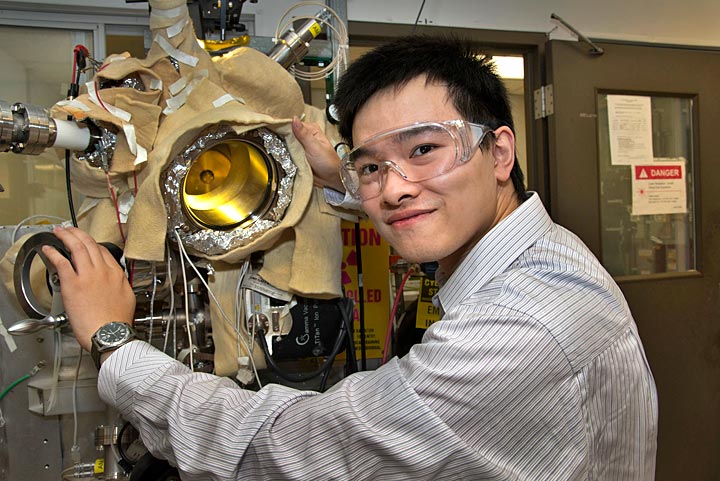BNL's Erdong Wang Named a Goldhaber Distinguished Fellow for Work in Accelerator Science
April 15, 2013

Erdong Wang with the GaAs photocathode preparation chamber for polarized electron SRF gun. The foil and brown wrapping is thermal insulation used to allow efficient heat of the equipment (dubbed "baking"), essential for the attainment of ultra-high vacuum in the test chamber.
Since he was a young boy, Erdong Wang has been curious about his surroundings and the world we live in. "Physics is the venue that helps us understand how energy and matter react – leading to a better understanding of how our world works," said Wang. "Physics is never boring and always fascinating."
This intense curiosity and fascination with the world led Wang to a career in physics, a job at Brookhaven Lab, and to recently being named a Goldhaber Distinguished Fellow.
Working with BNL scientist Ilan Ben-Zvi, Wang has conducted state-of-the-art research in the area of high-quantum efficiency photocathodes used in superconducting radiofrequency (SRF) electron guns, a technology that will play a key role in energy-conserving particle accelerators, such as an Energy Recovery Linear Accelerator (ERL). A small ERL is currently being built at Brookhaven as a prototype for future accelerator projects.
Wang's thesis research was on diamond amplifiers, little diamond capsules that are incorporated into the gun's structure to help produce a dense electron beam. For this construction, Wang developed a technique to reproducibly create diamond amplifiers, having studied the application of hydrogen-treated diamonds. His hypothesis — that the electron beam emission from the diamond surface depends on the applied field — was supported by experimental data and led to new information about the energy spread of the electrons inside the diamond. The results of Wang's research have impacts beyond the scope of his thesis, as diamond amplified photocathodes are likely to be essential for future electron guns.
Currently, Wang is working on new and innovative ideas in photocathode research and development that may have the potential to become cutting-edge and highly beneficial to the accelerator science community.
"Erdong's performance is absolutely outstanding in every aspect, from high-quality work to simulations and theory," said Ben-Zvi. "His knowledge and persistence make him destined to become renowned in the field of accelerator science."
"I am very grateful to everyone at the Lab, especially Ilan," added Wang. "He has been a wonderful mentor and role model."
Wang received his Ph.D. in physics at Peking University and joined Brookhaven National Laboratory in 2008. In addition to being named a Goldhaber Distinguished Fellow, Wang was also the recipient of the 2012 Particle Accelerator Science and Technology Doctoral Student Award.
Brookhaven National Laboratory created the Gertrude and Maurice Goldhaber Distinguished Fellowships Program with funding from Battelle Memorial Institute and Stony Brook University, partners in Brookhaven Science Associates. These prestigious Fellowships are awarded to candidates with exceptional talent and credentials who have a strong desire for independent research at the frontiers of their fields.
2013-3849 | INT/EXT | Newsroom









